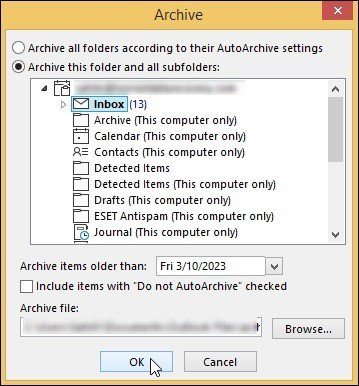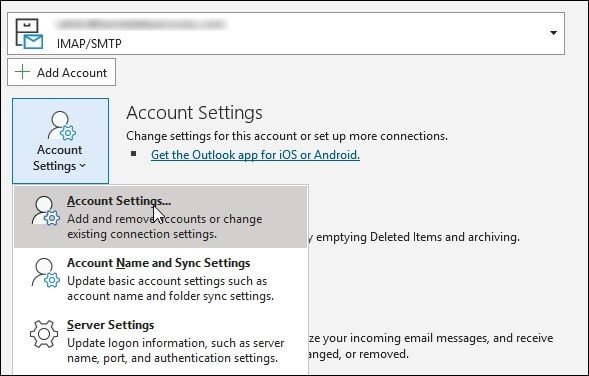How to
How to Fix Error- “Application Pauses if You Have a Large OST File”

Summary:
An oversized Outlook data file in your profile will surely act as an invitation to performance issues. Besides multiple error message, a large file also prompts to application pauses. The resolution to this problem lies in reducing the size of Outlook data file (.ost). In this guide, we will explore how to fix error- “Application Pauses if You Have a Large OST File.” The post will also put an OST to PST converter tool in the limelight to prevent this issue.
Introduction:
Microsoft Outlook is trusted email client all across the globe. Outlook’s distinctive features and user-friendly interface have won laurels from are trusted by individuals and business for its superb mailbox management capabilities. And what provides boost to Outlook’s capabilities are its two file formats– OST (Offline Storage Table) and PST (Personal Storage Table). The PST file serves as the main location to store email messages, contacts, tasks, and other mailbox data.
Offline Storage Table (OST) file is created by Microsoft Outlook, when it is configured with Exchange or IMAP account, to store all the online mailbox data on the local system. However, Microsoft has defined a particular limit for the OST file size. While Outlook versions 2013, 2016, 2019, and 2021 support up to 20GB, the versions 2010 and later support up to 50GB of data. If this file size limit is breached, the user may experience different performance related issues, including the ‘application pause.’ In this post, we will discuss ways to troubleshoot “Application Pauses if You Have a Large OST File” error. We will also cover an expert-recommended solution using OST to PST converter tool.
Understanding the Error and its Symptoms:
The OST file is a cornerstone of Microsoft Outlook’s functionality. It is created when you set up an Exchange email account on Outlook. But sometimes, the user faces application pauses owing to an oversized OST file. The Outlook application may get paused or become unresponsive when the user tries to open emails or compose email messages or searching the inbox. With the increase in OST file size, these issues also get increased, leading to frustration as well as loss of productive time. The issues arise when the size of an OST file exceeds 10 gigabytes (GB) or more.
Methods to Fix the Application Pauses Issue:
After understanding the error and its symptoms, let’s move on to resolve this error. In this section of the post, we will explore how to fix error-“Application Pauses if You Have a Large OST File.” Some of the popular methods to resolve this issue are listed below:
Fix 1: Archive Outlook Items: In your endeavour to reduce the mailbox (OST) size, we can archive old or unwanted mailbox content. Follow the below steps for the same:
Step 1: Navigate to the Outlook App, go to the File menu and hit on Tools option.

Step 2: Enter the Clean Up old items option.

Step 3: Explore the “Archive this folder and all subfolders” section, select the particular folder you want to archive.
Step 4: You can even select the entire mailbox to archive, opt for the email address to select the entire mailbox.
Step 5: Under Archive items older than an option, choose the Date Range.

Step 6: After that, Hit on Browse to save the archived mailbox and click the OK tab.
Fix 2: Auto-Archive Old Emails: Outlook is equipped with a powerful feature to transfer old emails to a separate archive folder. Enabling this feature ensures more space for Outlook data files. Follow the below steps to enable this great feature:
Step1: Explore the Outlook App and hit the File Option.
Step 2: Choose ‘Options’ from the left panel.

Step 3: Run Outlook and select the File option in the ribbon.
Step 4: Go for ‘Advanced’ from the left side Menu, then select ‘auto-archive setting’ from Auto-Archive section and press ‘OK’.

Step 5: Click on the Run AutoArchive every ‘n’ day’s box and specify how frequent you want Outlook to run AutoArchive.

Step 6: Once this process is completed, an Archive Folder will appear in your Outlook account.
Fix 3: Disable the Option for Cached Exchange Mode for Delegate Mailbox: Outlook’s Delegate Access features provides authorization to other users to perform functions like creating email messages or responding to meeting requests, etc. on your behalf. Enabling this feature means adding more to the size of the OST file. By disabling this feature, we can prevent the size of the OST file from exceeding the limit. Follow the below steps for the same:
Step 1: Explore to the MS Outlook application and navigate to the File tab.
Step 2: Choose Account Settings > Account Settings and press on your Exchange account. After that, press on ‘Change’ and then select ‘More Settings’ option.

Step 3: Then press Cached Exchange Mode Settings option.
Step 4: After that choose Advance tab, and uncheck the Download Shared Folder or Download Public Folder Favorites option.
Step 5: Press ‘Apply’ and then click ‘OK’.
Step 6: Restart your Outlook application.
Other Proactive Approaches to Fix Large OST Files:
In the above section, we have discussed sole popular methods to troubleshoot application pause issue arising because of a large OST file. In this part of the post, we will discuss some proactive approaches using which we can prevent the issue of ‘application pauses if you have a large OST file.’ Some of the recommended approaches are listed below:
- Set Items per Folder Limit: Setting a folder limit is a better idea. It may be noted that the Microsoft has set a limit of 100,000 items per folder in 2019, 2016, 2013, and 2010. If this limit exceeds, the Outlook will start experiencing performance issues. Thus, relying on the principle of ‘prevention is better than to cure’, we must set a limit per folder to minimize the possibility of performance issues arising from large OST file.
- Remove Expired Files: The next approach is to remove unwanted and expired data folders (email folders only) from Outlook. This feature is off by default and is available under options. Choose this check box to delete messages after their aging period has passed.
- Transfer Aging or Old Items: This feature of Outlook facilitates to move old emails and other data to archived PST files.
What Steps Should I take if all Methods Fail?
So, you have tried all above-mentioned methods and proactive approaches, but the problem of application pause due to large OST file still persists. In this case, we can use an OST to PST converter like Stellar Converter for OST to convert the OST file. It executes the fastest conversion of large OST file to PST. This software features an Auto-Split option that automatically splits an oversized Outlook PST file while saving the converted email items from OST files. This converter is available in 3 versions-Corporate, Technician and Toolkit versions to choose from.
Conclusion:
An oversized OST file is likely to get corrupted sooner or later. In addition to this, this large OST file also causes issues like performance degradation, application pauses, and other problems. In the above guide, we have discussed how to fix error- “application pauses if you have a large OST file.” We have also explored some proactive techniques like setting folder limits, removing old files, etc. to prevent this issue.
A large Outlook OST file can also become inaccessible. In such scenario, we can convert the damaged outlook data file using any OST to PST converter tool, like Stellar Converter for OST. It is worth mentioning that Stellar’s converter offers the fastest conversion of large OST to PST. This software also assures to preserve the original integrity of mailbox items.
Did you find this article helpful? Check out the rest of our blog.
How to
How to Get Fast Immigration Bond Assistance and Secure Release

What would you do if a loved one were suddenly detained by immigration authorities?
The fear and stress of such a situation can be overwhelming. But knowing how to get fast immigration bond assistance can make all the difference. The quicker you act, the sooner they can return home.
This guide will show you the steps to secure their release as fast as possible. With the right information, you can navigate the process with confidence.
Confirm Eligibility for Bond
Not everyone in immigration detention qualifies for a bond. A person may be denied a bond if they have a serious criminal history or are considered a danger to the community. If ICE refuses bond, the detainee can request a bond hearing before an immigration judge.
An immigration judge will decide if the detainee is eligible for release. The judge considers factors like family ties, employment history, and past immigration violations. A strong case with proof of stability and responsibility increases the chances of bond approval.
Get the Bond Amount
ICE usually sets the bond amount based on the detainee’s case. The minimum bond is $1,500, but it can be much higher depending on the person’s background. If ICE sets the amount too high or denies bond, the detainee can ask a judge to review the decision.
At a bond hearing, the judge may lower or raise the amount. The detainee or their lawyer must provide evidence that they are not a flight risk or a danger to the public. Having strong community ties and a clean record helps lower the bond.
Contact an Immigration Lawyer
An immigration lawyer can explain the bond process and provide legal advice. They can help request a bond hearing if ICE refuses to set a bond. A lawyer may also present evidence to convince the judge to reduce the bond amount.
Hiring a lawyer improves the chances of release. They can help gather documents that prove the detainee’s stability, such as proof of work and family support. A lawyer also ensures that the detainee understands the legal process and attends all required hearings.
Find an Immigration Bond Company
Many families cannot afford to pay the full bond amount on their own. Immigration bond companies provide financial assistance by covering most of the bond in exchange for a fee. These companies usually charge a non-refundable percentage of the total bond.
A bond company may require collateral such as property or valuables. If the detainee attends all court hearings, the collateral is returned. If they fail to appear, the bond company may seize the collateral to recover the cost.
If you are posting bond for someone in Texas, it is important to find a reliable company that understands local immigration policies. To ensure a smooth process, consider an immigration bond company in Texas that has experience handling cases in the state.
Freedom Is Just a Bond Away
No one should have to stay behind bars longer than necessary. Acting fast, knowing your options, and getting the right help can make all the difference. Immigration bond assistance is not just about money- it’s about reuniting families and restoring hope.
When faced with an immigration detention, knowledge is your greatest tool. Stay informed, stay prepared, and take action when it matters most.
CLICK HERE FOR MORE BLOG POSTS
How to
How to Choose a Company for Apartment Renovation: 5 Main Criteria

Choosing the right construction and renovation company is already 50% of the success of your apartment or house renovation. Non-professionals or hastily chosen specialists often cause missed deadlines, budget overruns, strained relationships with neighbors, and short-lived finishes. Ignorance or disregard for technical standards by such workers can lead to crooked tiles, squeaky floors within a month, or having to dismantle newly installed fixtures to find leaks. In this article, we will explain the criteria for finding a reliable renovation company and how to select a good team for the job.
1. Experience
It is important to analyze factors such as:
- The age of the company;
- The qualifications of the employees;
- The portfolio of completed projects.
The more extensive the portfolio, the better. It can include photos, videos of the work, detailed descriptions of services (what was done, in what time frame, what the final cost was), and the types of houses where the renovation was carried out. It is good if the company does not hide its employees and information about them.
An indirect positive sign to look for when choosing a renovation company is publications by the company’s experts on design, renovation, and material selection. These publications can include blog articles, interviews on thematic platforms, educational videos on YouTube, etc. This is additional confirmation of the team’s experience and authority.
2. Communication
When working with a renovation company, it is important not only to be heard but also to be listened to. In correspondence or phone conversations, evaluate:
- How the employees respond to questions;
- Their manner of communication and the depth of their understanding of the renovation topic;
- Do they respond quickly to calls/messages? Or do you have to wait days or weeks for feedback? Do the employees fulfill their promises (call back, send information)?
Overall, adequate behavior is a good sign for continuing the dialogue. This situation is similar to the process of choosing an online casino. When you study 台湾玩家常见的线上娱乐方式, in addition to the main criteria, you should also rely on the work of the support service. Otherwise, at the first difficulties with the payment or withdrawal process, you risk encountering an indifferent attitude.
3. Online Reputation
After forming a first impression, you can move on to studying reviews about the company on review platforms. When evaluating the rating of a construction firm, keep in mind that it is not always equal to the average of all ratings. Often, the company’s rating on the platform consists of a combination of different factors (from the frequency of ratings to the authority of the author). Therefore, it is better to delve into the content of the reviews themselves.
Evaluate the tone of voice or how the company responds to complaints. Does it try to understand and help solve the problem? Does it try to smooth over negativity or remain silent? Perhaps it even enters into polemics, attacks the customer, and threatens with court. In renovation, unpredictable surprises, reworks, and shifts in deadlines sometimes happen. This is completely normal. Good companies acknowledge their mistakes and learn from them, while “shoddy” ones remain silent about problems and thus face them again and again.
4. Pricing Policy
Price is one of the primary criteria for most clients when deciding how to choose a renovation company. Accurate pricing indicated on the official website speaks to the company’s transparency. However, if you are instantly given an attractive price, do not rush to rejoice – ask for justification of such a “beneficial offer.” A good renovation with quality materials and a skilled team cannot be cheap. A design project or technical assignment (measurement sheet with comments on the work) can help determine the specific renovation cost. Based on their calculations, you will receive a transparent estimate with a price you can rely on.
5. Designer
Renovation companies that offer design services are preferable. Firstly, they have experience in designer renovations; they know how to work with drawings and with expensive and exclusive materials. Secondly, such companies often run promotions, and you can receive a layout solution from a designer or another useful service as a gift along with the renovation.
Contractor Selection Made: What’s Next?
As we wrote at the beginning of the article, a successful contractor choice is half the success of the renovation. The second half is the joint effort of the client and the renovation team. If there are no special agreements with the foreman or designer’s supervision, it is not enough to just hand over the keys, pay the money, and wait for everything to be done exactly as you want. As a rule, additional control over the progress of renovation work, procurement, and the use of materials will only be beneficial and help avoid misunderstandings at the end of the renovation.
Conclusion
The choice of the most suitable construction and renovation firm is the key to a successful house or apartment renovation. Remember that the success of your project relies on cooperation between you and the renovation team. With the right approach, you will achieve the desired result and avoid typical errors. Good luck with your renovation!
How to
How to Ensure a Smooth and Secure Bail Release Process

How can you ensure a smooth and secure bail release process?
Navigating the bail system can be confusing, but understanding the key steps can make a big difference. Knowing what to expect, what documents are needed, and how to work with the right professionals will help make the process easier.
Whether it’s your first time dealing with bail or you’re familiar with the system, it’s essential to stay informed. Ready to get started? Keep reading to learn the steps that will help guide you through a hassle-free and secure bail release experience.
Choose a Trusted Bail Bondsman
Picking the right bail bondsman is key to a smooth bail release. Find someone who is licensed and has good reviews. A trusted bondsman will explain the process clearly and be honest about costs. They should be easy to reach if you have questions.
It’s also important to choose a bondsman with experience in cases like yours. A professional Orange County bail bonds with a strong reputation will work hard to make the process quick and simple. Their experience can help avoid delays and make sure the defendant gets released on time.
Understand the Bail Conditions
Knowing the bail conditions is crucial for a smooth release process. Each case has specific rules, such as when the defendant must appear in court and any behavior restrictions.
Make sure you clearly understand these terms and the consequences of not following them. Missing court dates or breaking conditions could lead to the bail being revoked. It’s also important to keep track of deadlines, such as when the bail amount needs to be paid.
By staying informed and following all the rules, you can help prevent any setbacks. This understanding brings peace of mind, knowing that everything is in place for the defendant’s safe and timely release.
Provide Accurate Information
Giving the right information is important for a smooth bail release. The bail bondsman will need clear details about the defendant, like their full name, charges, and any past criminal record. Errors or missing information can cause delays.
Be honest and upfront about anything special, like past court appearances or problems with bail. This helps avoid confusion and keeps things on track. The more accurate the details, the easier it is for everyone involved.
Getting the facts right from the start makes the process go faster and helps avoid extra stress. It’s key to moving forward without delays.
Stay in Contact with the Bail Bondsman
Staying in contact with the bail bondsman is key to a smooth release process. Regular communication ensures that any updates or changes are shared quickly. If there are issues or delays, the bondsman will be the first to inform you.
Keeping in touch also helps ensure that any requirements, such as court dates or additional paperwork, are met on time. By staying connected, you can avoid confusion and ensure everything goes as planned. Consistent communication helps the process stay on track and move forward without unnecessary delays.
Completing Your Bail Release Process with Confidence
By following these simple steps, you can ensure a smooth and secure bail release. Choosing a trusted bail bondsman, understanding the bail conditions, providing accurate information, and staying in contact with the bondsman all play a vital role in making the process easier.
With the right preparation and attention to detail, you can move forward with confidence and avoid unnecessary delays or stress.
-

 Entertainment11 months ago
Entertainment11 months agoSandra Orlow: Exploring the Life and Legacy of a Cultural Icon
-

 General7 months ago
General7 months agoBaby Alien Fan Bus: Watch Parts 2 & 3 on Twitter, Reddit!
-

 General7 months ago
General7 months agoDiana Nyad & Bart Springtime: A Swim to Success
-

 Business12 months ago
Business12 months agoTex9.Net Crypto: Fast, Secure International Money Transfers with Competitive Rates
-

 Business12 months ago
Business12 months agoWhat is O Farming: How to Make Money Online and Its Start-Up Benefits
-

 Business11 months ago
Business11 months agoSnapchat Planets: Exploring Your Streak Universe
-

 General10 months ago
General10 months agoDeeper Dive into myfavouriteplaces. org:// blog
-

 Business12 months ago
Business12 months agoFintechZoom Apple Stock: Real-Time Insights and Expert Analysis
